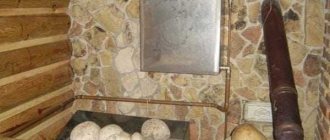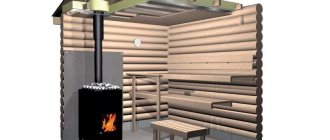When choosing a stainless steel tank for hot water for a bath, you need to accurately determine two parameters. The first is the maximum number of people in the steam room, the second is the place where the container for hot water will be located for washing or watering the heater. All other structural parts made of stainless or alloy steel are selected based on the bathhouse owner’s own preferences.
Stainless steel water tank
A container for heating and storing water in a steam room or dressing room can be obtained in two ways:
- Buy from a specialized salon that sells equipment for baths. Branded stainless steel water tanks are quite expensive, on average $200-250. There is no point in purchasing cheap consumer goods, as well as trying to make them from Chinese stainless steel of dubious quality. After a couple of years, the entire stainless steel structure burns out faster than domestic alloy and even ferrous metal;
- Order from the masters. High-quality stainless steel water tanks for baths are manufactured for $150 on average in 5-7 days. The master will only need a drawing and dimensions; sometimes you have to buy material or agree on the grade of steel, this is especially important if you plan to make a samovar or a mounted type of tank for a furnace.
The third method involves making stainless steel tanks yourself. The task is not easy, but it is quite within the capabilities of a person familiar with the operation of a carbon dioxide, or better yet, an argon semi-automatic device.
For your information! Traditionally, tanks for a stainless steel bath stove are assembled by welding from pre-cut metal 1-1.5 mm thick.
The metal is very thin for welding and will require some practice and good welding equipment, which can be easily found at your nearest auto repair shop. Therefore, before you decide whether to make a stainless steel tank for a bathhouse with your own hands or buy a ready-made one, you need to really assess your capabilities and choose the design of a metal container.
Features of the operation of mounted tanks
Cylindrical containers, or “samovars,” operate under the most severe conditions of high temperature. The chimney wall can heat up to 500-600°C. The metal of the walls burns into scale, as they say, to holes. In this case, using a stainless steel pipe for a sauna tank can be considered the best option.
The lower part of the tank is a metal glass with which the container is placed on the flange of the heater. This is the most loaded part of the structure. In addition to the high temperature of the walls, the weight of the tank itself and the water supply presses on the lower part of the stainless steel body. Plus, the hot glass gets the most boiling water and steam from the stones. In such conditions, ferrous metal burns out into rusty dust within a few months, so when choosing a specific tank model, pay attention to the bottom of the container; the thickness of the metal in this place should be at least 1.5 mm.
When choosing and inspecting stainless steel tanks for a bathhouse stove, it is imperative to pay attention to the quality of the welds on the bottom of the tank. The bottom part of the container of tanks from well-known Finnish and Swedish manufacturers is made of thicker metal or reinforced with stiffeners. In addition, the welding seams at the junction of the inner pipe, bottom and outer walls must be smooth and continuous, this indicates high quality welding.
Attention! Stoves and heaters in the bathhouse, equipped with mounted stainless steel tanks, cannot be heated without water.
If a container for hot water made of non-alloy steel is often deliberately not filled with water until the heater is ignited and completely lit, in order to speed up the process of gaining temperature, then in the case of stainless steel, such a “trick” can result in a burst wall or a dented bottom. Alloy steel has low thermal conductivity and a high coefficient of thermal expansion, therefore, during “dry” heating, severe stresses arise in the stainless steel glass and bottom part.
If a similar situation occurs, then you cannot pour water into an alloy steel container; you need to turn off the firebox and allow the stainless steel tank to cool to at least 50-60°C.
Options for stainless steel tanks for sauna stoves
To heat water using secondary heat, heater stoves use three types of containers:
- A mounted tank, the most efficient in terms of heat engineering, is popularly nicknamed the “samovar”. Water in a stainless steel container heats up 2-3 times faster than the heating of the bathhouse;
- Wall-mounted stainless steel container. The easiest tank to make, made of thin stainless steel, is not suitable for all types of stoves. Heats up slowly;
- A remote type tank can be made from stainless steel or any other type of metal. The water for the bath heats up very slowly, but due to the design of the heat transfer system from the stove, it can be located outside the steam room.
Mounted models are most often offered for sale; wall-mounted and remote structures are made according to individual drawings and diagrams, and therefore are more expensive. A remote tank is considered the safest and most convenient to use; often a stainless steel container provides water not only for the steam room of the bath, but also for the shower and the washing compartment.
Tank on a pipe for a stainless steel bath
It is not for nothing that a mounted container for heating water is popularly called a samovar tank. Structurally, the tank is a rectangular or cylindrical body with flat bottoms, inside of which a piece of stainless steel pipe is welded.
In the lower part, a tap for hot water is mounted into the wall of the stainless steel tank, and the upper part is equipped with a slide valve. By turning or moving the damper, the draft in the combustion chamber is adjusted.
A window must be cut out in the upper horizontal wall to inspect the internal space and fill in cold water. Alternatively, the stainless steel bottom can be removable or have a hinged flap. Periodically, the stove and tank in the bathhouse are cleaned of carbon deposits and scale, therefore, the larger the window, the easier it is to maintain the tank.
The principle of heating water is very simple. A stainless steel tank is installed at the outlet of furnace gases from the furnace, the rest of the chimney is mounted on a scraper flange. Hot gases flowing through the container through the inner pipe heat the stainless steel walls to 600-700°C. Under such conditions, the water in the bathhouse boils before the bathhouse is heated. The outer walls of the tank remain relatively cold, 70-90°C, and therefore rot and oxidize much less than the inner pipe, for which the most heat-resistant grades of stainless steel are used.
The shape of the body can be cylindrical, rectangular, with sharp or rounded edges. For the process of heating water in a bathhouse, the design of the tank is not particularly important. Manufacturers produce containers from enameled and nickel-plated metal, but most often from stainless steel, in order to give the water-heating container for a bath a more presentable appearance.
Hanging tank made of stainless steel for a bath
Unlike the universal “samovar”, which is suitable for almost any bathhouse, wall-mounted water containers can only be used in heater stoves with a flat side or back wall.
Structurally, a hanging water tank looks like a flat container with side walls made of thin stainless steel. Due to their shape and size, such water collectors are popularly called “suitcases”.
Unlike a top-mounted model with a flow pipe, a top-mounted tank does not have through holes or built-in heating devices. It is attached directly to one of the side walls of the steel body of the stove, while the decorative lining of the stove firebox must be cut or dismantled before installing the tank. According to the conditions for effective heating, the side wall of the stainless steel water heater must fit tightly directly to the body of the combustion chamber. The larger the contact area, the faster the water in the tank heats up.
The dimensions of the stove are increasing, so the model of the tank and the method of installing it in the bathhouse must be agreed upon in advance so as not to clutter the useful space of the steam room with a hung water heater.
Sometimes owners try to attach a stainless steel container to the back wall of the combustion chamber, but in this case the water heats up much more slowly, and it is not as convenient to draw it as from a mounted “samovar”. The back side of the firebox is usually the coldest; most of the hot combustion products are taken up by the chimney and simply do not reach the rear wall.
For your information! Over time, due to burning and the formation of scale on the furnace body, the contact between cast iron and stainless steel worsens, thermal resistance increases, so the time for heating water for the heater and washing in the bath can increase by 40-60%.
The relatively simple shape and design make a stainless steel container the most suitable option for making a water heater with your own hands. At the same time, the service life of a hanging tank in a bathhouse is 10-15 years.
Tank for sauna stove made of stainless steel
The remote-type hot water tank system is considered the most convenient for the conditions of a modern bathhouse. The heating structure consists of four elements:
- Tank made of aluminum, heat-resistant plastic or nickel-plated steel. Two fittings and a drainage tap are mounted in the lower part of the container; a filler hole for water is cut out in the upper part;
- Two flexible stainless steel pipelines and two taps for hot water;
- The heat exchanger is most often a bent arc of an inch alloy steel pipe.
The operating principle of such a water heating tank completely coincides with the design of a pumpless water heating system, which is still used in private houses and bathhouses.
A stainless steel tank is installed at a height of 150-160 cm in a steam room or dressing room, the second part - a heat exchanger made of chromium alloy steel - is mounted in the furnace firebox. Often, instead of a home-made device, owners buy an industrial-made stove for a bathhouse with a ready-made built-in coil. The heat exchanger and tank are connected to each other by two flexible metal corrugations.
In theory, for normal operation of the water heating system in the bathhouse, preheating is required for 30 minutes. and the same amount to heat 10-15 liters of water to 50°C.
A remote stainless steel tank can be located at a distance from the stove of no more than 180-200 cm, this is quite enough for spraying the heater and operating the shower cabin.
Combined stainless steel tank
In the event that the design of the furnace does not provide for an internal heat exchanger, and cutting and drilling the cast iron body is difficult, and there is no desire, you can solve the problem using a combined system of two tanks. One of which must be made of stainless steel, the second - from any corrosion-resistant metal.
In this case, there is no need to buy a new stove for the bath; instead of an internal heat exchanger, a small mounted tank with a capacity of 10-15 liters is used. The rest of the water heating system for the bath is manufactured as for the remote version.
As a result, there is hot water for the heater and warm water for the washing section of the bathhouse.
Cast iron
Cast iron boilers have long been used in village baths, so they have stood the test of time.
The advantages of such containers:
- They are not subject to rust, so the water in them always remains clean and suitable for use.
- Cast iron does not conduct heat well, so the water in such a boiler stays hot for a very long time.
But among the disadvantages we can name the following points:
- Cast iron has a very high specific gravity, therefore such a boiler will be very heavy and will require the construction of a very strong base. In addition, it will be very difficult to install it yourself.
- Due to the advent of lighter and more accessible materials, cast iron products are now almost never produced, so purchasing such a boiler can be almost impossible.
- You will have to spend a lot of money to purchase a cast iron boiler.
How to make a stainless steel tank with your own hands
To meet the needs of the steam room, at least 10 liters of water are required for each visitor to the steam room. On average, for a sauna stove, stainless steel tanks with a capacity of at least 60 liters are made; for three people this is enough to steam and wash in the shower. There are also water heaters with a capacity of 70, 80 and even 100 liters.
One of the options for a 70-liter tank, made of thin-sheet stainless steel, is shown in the drawing below. The full capacity is 90 liters, but given the danger of water boiling, such bathhouse structures are designed with a small volume reserve, in this case 20%.
Problems of making samovars
If you have no experience in building mounted stainless steel structures, then it is best to start making a wall-mounted model, or, as a last resort, try to make a remote tank.
The main problem in the production of stainless steel samovars remains the quality of welding and balance. First of all, high demands are placed on the quality of the support cup or piece of pipe on which the tank stands on the furnace body. Due to the high temperature, up to 700°C, and the huge weight of the “samovar”, about 70 kg, high quality material and welding of the central seam are required.
Otherwise, the circular seam on the stainless steel, photo, may crack and the tank will lose its tightness. The second problem is that if the body is welded with a violation of the geometry asymmetrically, then any deviation from the vertical can result in the entire structure overturning.
Compared to a “samovar”, a wall-mounted stainless steel tank is simpler and more affordable to manufacture.
Materials and tools
When making any stainless steel containers yourself, you first need to choose the right material or grade of steel. In the nomenclature or assortment you can find a huge number of stainless steel sheets, but for self-production it is best to use a grade with a high silicon or carbon content.
In this case, there is a chance to weld thin-sheet stainless steel for a bath with a minimum amount of defects. Doing such work for a non-professional is not as easy as it might seem. If the question in the foreground is how hygienic and safe the use of alloy steels is in a bathhouse, then it is best to choose 08Х17 or 12Х18Н10:
- Both brands have high ductility, which means that the welding seams of the tank will not crack under high heat;
- There is a chance to weld the body of the water heater using a conventional carbon dioxide semi-automatic machine;
- The tank is absolutely safe for the bath; tableware is made from these grades of stainless steel.
In addition to sheet stainless steel, you will need to purchase or rent an angle grinder, a set of marking steel rulers and angles, clamps and a carbon dioxide welding machine itself, with wire for performing work on stainless steel. Later, to hang the tank on the bathhouse wall, you will need dowels and mounting brackets.
Step-by-step instruction
The first step is to lay out the sheet metal on a flat horizontal surface. Using rulers and squares, we transfer the dimensions from the drawing to the sheet so that the material is used with a minimum amount of waste and trimmings.
The second step is to cut the pattern on the stainless steel, align and clean the edges of the tank wall blanks to a state of absolutely straight lines, the presence of burrs does not matter, everything will be covered by the welding seam.
Next, we assemble the side wall of the tank with the end surfaces one by one, we do this with the help of clamps. We fix the stainless steel sheets using welding points.
We connect the assembled halves into one body, clamp them with clamps and weld the seams, first in short sections, then let it cool and weld the entire product along the contour.
Before placing the water heater in the bathhouse, pour water inside and check for possible leaks at the seams. Usually, welded seams on bathhouse stoves are checked with kerosene; in this case, water with a small addition of liquid soap will do.
The external seams are rubbed with chalk or tooth powder. If the grout layer on the stainless steel is not darkened by water, then the seams are considered airtight. After installing the lid, underwater fittings and drain valve, the stainless steel tank can be sent to the bathhouse for assembly.
Stainless steel tank: installation in a bathhouse
Mounted tanks are the easiest to install. It is necessary to install a ring coupling that secures the water heater to the stove chimney, then install the support glass and the stainless steel tank body itself. The last thing to install on the body is a gate unit and a chimney pipe going to the roof of the bathhouse.
To install a wall-mounted water heater on a stove, use mounting clamps and bolt fastening. The stainless steel box must be pressed against the wall with a force of 8-10 kg.
The installation of a remote water heater is considered the most difficult. The tank itself is suspended on dowels and mounting loops at a height of at least 150 cm.
Next, in accordance with the diagram, metal corrugations are laid along the bathhouse. Typically, connection conditions require that the pipes be located at an angle of at least 30° to the horizon. But in practice, water heating tanks made of stainless steel of the combined type work normally in a bathhouse, even with a slope of 10°.










